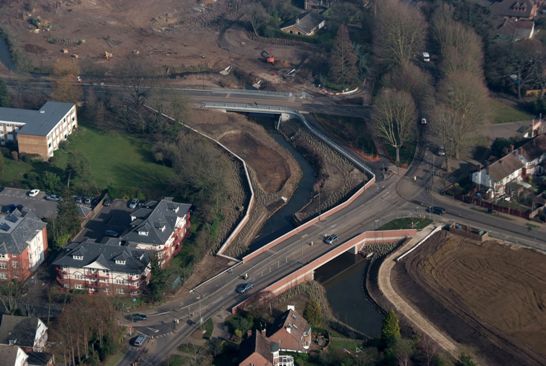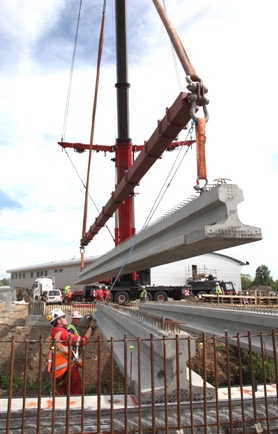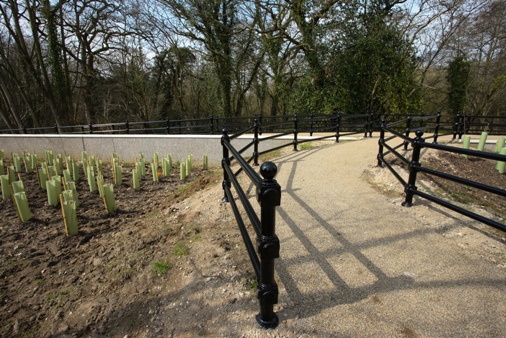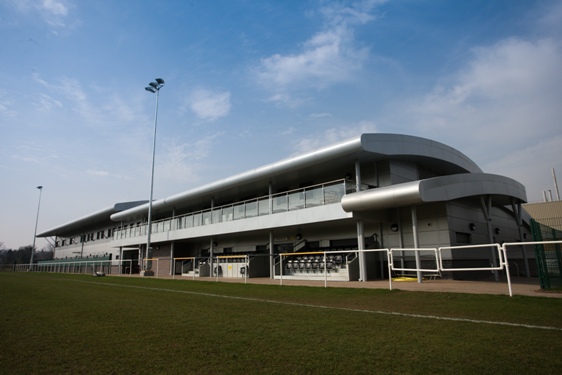The Hoe Valley regeneration project |
|
Whole Project Award
Project Team
Client: Woking Borough Council, Environment Agency, Thamesway Development Ltd and Turner & Townsend (Client Project Manager)
Designer: Halcrow
Construction: VolkerFitzpatrick and VolkerStevin Joint Venture
The Hoe Valley Scheme is a multifunctional scheme designed to protect over 198 homes from flooding. The £30m project involved the delivery of new flood defences along a 2km stretch of the Hoe Stream. This would provide flood protection to 198 residential properties, 60 gardens and Westfield School from the flood plain. The project also included land remediation, significant highway improvements including new bridges, new state of the art community facilities and extensive public open space with new wildlife habitats. CEEQUAL was integrated into the planning of the project from the initial negotiations with the client.

Planning
Sustainability was a major project driver from the beginning. Measures were taken to encompass as many environmentally sustainable elements into the project as possible; an environmental clerk attended the site, there was input from an ecologist on a day to day basis at the start of the project with further input throughout the project and monitoring by a compliance engineer.
Knowing how important communication and collaboration would be for this project, regular update meetings were undertaken with the Environment Agency to ensure that the environmental impacts of the project were communicated to the client team. On top of this, a team building workshop including VolkerFitzpatrick staff, engineering and environmental team members was carried out at the very start of the project. This ensured an integrated environmental approach to the development of the design. With this system in place we were able to face challenges and think ahead with sustainability in mind.

Waste Management
Part of the site was contaminated by a former tip. The project ensured that the tip (110,000m³) was remediated and the materials re-used on site under the CL:AIRE protocol. A remediation action plan was developed and agreed with the Environment Agency and an Environmental Health Officer.
At the start of the project there was an estimated 30,000m³ of surplus material on the site due to the creation of flood compensation areas. The commitment of the entire team in remediating and re-using material on site has resulted in only 700m³ (0.64%) of material having to be disposed from the site. All material on site has been re-used in the construction of landscape bunds, flood defences and the residential development platform. The team even went as far as raising the level of the entire community facilities building and football pitch to reduce off-site disposal.
It was identified that the available clay on site was unsuitable to create the clay core of the flood embankments. The project team identified the use of a geosynthetic clay liner to give the required impermeability. This again ensured that the on-site material could be used, saving the removal of 10,000m³ and import of 10,000m³ of material.

Sustainability and Climate
For flood defences, passive design was promoted to reduce future maintenance and operation costs. An example; the team challenged the original requirement for all surface water outfalls greater than 300mm in diameter passing through the defences to have a secondary back-up penstock. These penstocks would have required manual intervention and advanced warning that there was a potential flood event. The team redesigned this system with secondary flap valves to avoid manual interventions and hence reduced future operational costs.
Climate change predictions were considered in the design development of the scheme, in particular the impact of increased rainfall and river flows increasing the flood risk. The entire scheme was designed for the 1 in 100 year event + 20% increase in flows for climate change. The flood walls and bunds were designed with an additional 300mm of height to enable the scheme to continue to provide a high standard of protection when the impacts of climate change occur. In addition to this, should the actual rate exceed predictions, the defences can be modified and raised 300mm without any strengthening work and up to 500mm with some additional strengthening works, allowing the project to be adapted to more extreme climate change impacts.
Bridges were designed to minimise the maintenance requirements and hence reduce energy consumption during their life. They were designed as integral structures without any bearings and with a 120 year design life, therefore no maintenance is required to the main elements of the bridge structure.

Water Resources and the Water Environment
A significant element of the scheme design focused on improving the water environment. This was completed by treating and removing all contaminated material located next to the watercourses, thus removing the potential of contaminated water entering into the Hoe Stream.
Ecology and Biodiversity
The number of new trees planted during the works far exceeded those that had to be removed; every measure was taken to preserve the trees situated on the construction sites, however, where the flood compensation area was created it was impossible to avoid removing trees as this would alter the effectiveness of the flood protection. In order to compensate for this, care was taken to improve old habitats and also create completely new ones:
- 777 new trees were planted
- 24,875 native species shrubs
- 2568 hedge plants.
A new wetland area has been created where the former council tip was located. The wildlife habitat has been increased by over 50%.
When construction works were completed bat boxes and mammal shelves were installed to allow mammals to travel safely from one side of the bridge to the other.
VolkerFitzpatrick also created a number of log habitats using the remains of the trees that needed to be removed as part of the remediation and flood defence works. Another measure undertaken was the creation of a stepped bank area between one of the newly created ponds and the Hoe Stream to assists voles.

Transport
Junction improvements to the area undertaken as part of the project have had a positive impact on the flow of traffic leaving the town.
Circulation of cars, cycles and pedestrians has improved throughout the site. Provision was given to cyclists by providing cycle paths separate from vehicle access, as well as cycle parking included at the new community building. Vehicle users have been catered for by the re-construction of two road bridges and the construction of one new road bridge with the addition of a replacement pedestrian bridge that is now Disability Discrimination Act (DDA) compliant.
Local Community
During construction works the team used various different forms of communication to involve the local community. Information was provided to local residents through frequent newsletters, the quarterly Woking Borough Council magazine to all residents, presentations to local interest groups and media days. A full time public engagement officer was employed for the duration of the project, providing community liaison and monitoring all on site noise and air pollution. Highlights included a visit from David Cameron PM.
Temporary paths allowed public access through the site whilst works were underway to allow people to be able to continue their normal routine. There were some diversions required to ensure that the highest level of safety for the general public could be maintained, e.g. the closure of the footpaths running through the former tip.
The project also provided new facilities for the benefit of the local community:
- An existing run down play area has been replaced by a new multi-use games area (MUGGA).
- A new play area provided close to proposed future housing.
- Areas of the site formally closed off to the public have been made accessible, improving public access.
- New paths and two cycle paths have been created to improve circulation around the site and provide links to surrounding residential areas and facilities.
- New seating, picnic benches and litter bins have been erected
- A replacement boardwalk has been provided at Hoebrook pond.
- Two new ponds/wetlands have been created.
- Interpretation boards are to be installed explaining the new habitats created.

